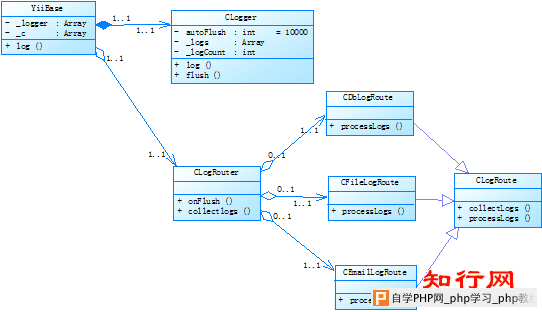Yii的自带组件有一个很实用的日志记录组件,使用方法可以参考Yii官方文档,在文档中提到,只要我们在应用程序配置文件中配置了log组件,那么就可以使用
Php代码 收藏代码
Yii::log($msg, $level, $category);
进行日志记录了。
配置项示例如下:
Php代码 收藏代码
array(
……
‘preload’=>array(‘log’),
‘components’=>array(
……
‘log’=>array(
‘class’=>‘CLogRouter’,
‘routes’=>array(
array(
‘class’=>‘CFileLogRoute’,
‘levels’=>‘trace, info’,
‘categories’=>’system.*’,
),
array(
‘class’=>‘CEmailLogRoute’,
‘levels’=>‘error, warning’,
‘emails’=>‘admin@example.com’,
),
),
),
),
)
log组件的核心是CLogRouter,如果想使用多种方式记录日志,就必须配置routes,可用的route有:
• CDbLogRoute: 将信息保存到数据库的表中。
• CEmailLogRoute: 发送信息到指定的 Email 地址。
• CFileLogRoute: 保存信息到应用程序 runtime 目录中的一个文件中。
• CWebLogRoute: 将 信息 显示在当前页面的底部。
• CProfileLogRoute: 在页面的底部显示概述(profiling)信息。
下面分析一下log的实现:
首先看一下CLogRouter的代码:
Php代码 收藏代码
/**
* Initializes this application component.
* This method is required by the IApplicationComponent interface.
*/
public function init()
{
parent::init();
foreach($this->_routes as $name=>$route)
{
//初始化从配置文件读取的route,保存在成员变量里
$route=Yii::createComponent($route);
$route->init();
$this->_routes[$name]=$route;
}
//绑定事件,如果触发了一个onFlush事件,则调用CLogRouter的collectLogs方法
Yii::getLogger()->attachEventHandler(‘onFlush’,array($this,‘collectLogs’));
//绑定事件,如果触发了一个onEndRequest事件,则调用ClogRouter的processLogs方法
Yii::app()->attachEventHandler(‘onEndRequest’,array($this,‘processLogs’));
}
/**
* Collects log messages from a logger.
* This method is an event handler to the {@link CLogger::onFlush} event.
* @param CEvent $event event parameter
*/
public function collectLogs($event)
{
$logger=Yii::getLogger();
//调用每个route的collectLogs方法
foreach($this->_routes as $route)
{
if($route->enabled)
$route->collectLogs($logger,false);
}
}
接着,我们看一下在调用Yii::log();时,发生了什么:
Php代码 收藏代码
/**
* Logs a message.
* Messages logged by this method may be retrieved via {@link CLogger::getLogs}
* and may be recorded in different media, such as file, email, database, using
* {@link CLogRouter}.
* @param string $msg message to be logged
* @param string $level level of the message (e.g. ’trace’, ’warning’, ’error’). It is case-insensitive.
* @param string $category category of the message (e.g. ’system.web’). It is case-insensitive.
*/
public static function log($msg,$level=CLogger::LEVEL_INFO,$category=‘application’)
{
if(self::$_logger===null)
self::$_logger=new CLogger;
if(YII_DEBUG && YII_TRACE_LEVEL>0 && $level!==CLogger::LEVEL_PROFILE)
{
$traces=debug_backtrace();
$count=0;
foreach($traces as $trace)
{
if(isset($trace['file'],$trace['line']) && strpos($trace['file'],YII_PATH)!==0)
{
$msg.=“\nin ”.$trace['file'].‘ (‘.$trace['line'].‘)’;
if(++$count>=YII_TRACE_LEVEL)
break;
}
}
}
调用CLogger的log方法
self::$_logger->log($msg,$level,$category);
}
继续看CLogger:
Php代码 收藏代码
class CLogger extends CComponent
{
const LEVEL_TRACE=‘trace’;
const LEVEL_WARNING=‘warning’;
const LEVEL_ERROR=‘error’;
const LEVEL_INFO=‘info’;
const LEVEL_PROFILE=‘profile’;
/**
* @var integer how many messages should be logged before they are flushed to destinations.
* Defaults to 10,000, meaning for every 10,000 messages, the {@link flush} method will be
* automatically invoked once. If this is 0, it means messages will never be flushed automatically.
* @since 1.1.0
*/
public $autoFlush=10000;
……
/**
* Logs a message.
* Messages logged by this method may be retrieved back via {@link getLogs}.
* @param string $message message to be logged
* @param string $level level of the message (e.g. ’Trace’, ’Warning’, ’Error’). It is case-insensitive.
* @param string $category category of the message (e.g. ’system.web’). It is case-insensitive.
* @see getLogs
*/
public function log($message,$level=‘info’,$category=‘application’)
{
//将日志信息保存在成员变量(数组)中
$this->_logs[]=array($message,$level,$category,microtime(true));
$this->_logCount++;
//如果数组数量到了autoFlush定义的数量,那么调用flush方法
if($this->autoFlush>0 && $this->_logCount>=$this->autoFlush)
$this->flush();
}
/**
* Removes all recorded messages from the memory.
* This method will raise an {@link onFlush} event.
* The attached event handlers can process the log messages before they are removed.
* @since 1.1.0
*/
public function flush()
{
//触发onflush方法,这时会触发CLogRouter的onflush事件
//参见上面CLogRouter的代码,会调用collectLogs方法
$this->onFlush(new CEvent($this));
//清空日志数据
$this->_logs=array();
$this->_logCount=0;
}
回到CLogRouter,调用collectLogs实际是调用配置中的每一个Route的collectlogs方法
,这个方法是所有route继承自CLogRoute(注意,不是CLogRouter)的:
Php代码 收藏代码
/**
* Retrieves filtered log messages from logger for further processing.
* @param CLogger $logger logger instance
* @param boolean $processLogs whether to process the logs after they are collected from the logger
*/
public function collectLogs($logger, $processLogs=false)
{
//获取日志记录
$logs=$logger->getLogs($this->levels,$this->categories);
$this->logs=emptyempty($this->logs) ? $logs : array_merge($this->logs,$logs);
if($processLogs && !emptyempty($this->logs))
{
if($this->filter!==null)
Yii::createComponent($this->filter)->filter($this->logs);
//调用processlog方法
$this->processLogs($this->logs);
}
}
/**
* Processes log messages and sends them to specific destination.
* Derived child classes must implement this method.
* @param array $logs list of messages. Each array elements represents one message
* with the following structure:
* array(
* [0] => message (string)
* [1] => level (string)
* [2] => category (string)
* [3] => timestamp (float, obtained by microtime(true));
*/
//processlog是由CLogRoute的各个route子类实现的
//例如数据库route用数据库存储,文件route用文件存储……
abstract protected function processLogs($logs);
至此,整个记录日志的过程就清楚了,下图是类关系:

Yii日志记录 |